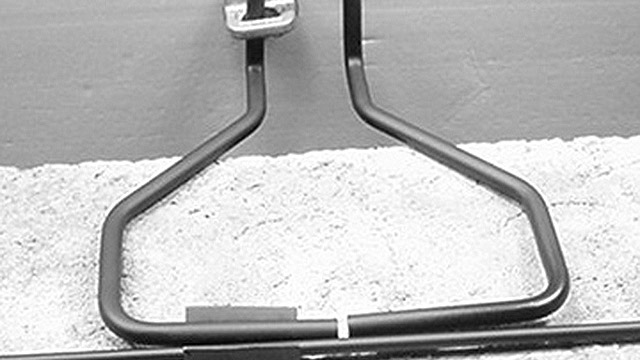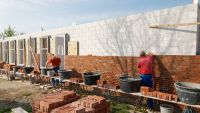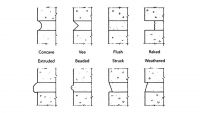2013 changes in the Masonry Code
Are you aware of the changes?
By Paul Curtis
Since the late-1980s, the Masonry Standards Joint Committee (MSJC) has been meeting to shape the masonry building code for our industry. The code is revised every three years. However, this last cycle was reduced by one year to coincide with the development schedule for the upcoming 2015 International Building Code (IBC).
The latest TMS 402 edition reorganized the code from eight chapters and one appendix to five parts, 14 chapters and three appendices. The reorganization was in response to past requests concerning the length of Chapter 1 and the difficulty in finding provisions. The new layout is more user-friendly and will better facilitate the use of these design provisions.
| 2011 | 2013 |
| Part 1: General | |
| 1. General Design Requirements for Masonry | 1. General Requirements |
| 2. Allowable stress Design of Masonry | 2. Notation and Definitions |
| 3. Strength Design of Masonry | 3. Quality and Construction |
| Part 2: Design Requirements | |
| 4. Prestressed Masonry | 4. General Analysis and Design Considerations |
| 5. Empirical design of Masonry | 5. Structural Elements |
| 6. Veneer | 6. Reinforcement, Metal Accessories, and Anchor Bolts |
| 7.Glass Unit Masonry | 7. Seismic Design Requirements |
| Part 3: Engineered design Methods | |
| 8. Strength Design of Autoclaved Aerated Concrete (AAC) Masonry | 8. Allowable Stress Design of Masonry |
| Appendix B – Design of Masonry Infill | 9. Strength Design of Masonry |
| 10. Prestressed Masonry | |
| 11. Strength Design of Autoclaved Aerated Concrete (AAC) Masonry | |
| Part 4: Prescriptive Design Methods | |
| 12. Veneer | |
| 13. Glass Unit Masonry | |
| 14. Masonry Partition Walls | |
| Part 5: Appendices, Conversions & References | |
| Appendix A: Empirical Design of Masonry | |
| Appendix B: Design of Masonry Infill | |
| Appendix C: Limit Design Method |
Code changes in 2013
- A new ASTM C-90 changed reduced limits on web thickness of CMU units and added normalized web area. Shear stresses in web must be checked with unreinforced masonry if the normalized web area is less than 27 in.²/ft².
- Revisions of design requirements for partially grouted shear walls: There is a new 0.75 reduction in shear strength for partially grouted shear walls.
- Mechanical splices in flexural reinforcement in plastic hinge zones shall develop the specified tensile strength of the spliced bar, instead of the 125 percent of the specified yield strength of the bar.
- Welded splices now require the reinforcement to conform to either ASTM A706 or a chemical analysis and carbon equivalent of the reinforcement steel.
- Masonry cement mortar now is permitted for fully grouted participating elements in Seismic Design Category D and higher.
- Modulus of Rupture Values have been increased.
- Addition of Appendix C – Limit Design of Masonry. This was added as an alternative seismic design approach for special reinforced masonry shear walls.
- Creation of an entire new Chapter (14) for the prescriptive design of masonry partition walls. This chapter originated from the 2011 Chapter 5 Empirical Design of Masonry. Existing empirical partition wall provisions were modified using rationale analysis and now include prescriptive designs for some basic masonry elements. Partition wall provisions have been removed from Appendix A in the 2011 version.
- Movement of The Empirical Design of Masonry from Chapter 5 to Appendix A with the addition of a checklist to assist designers in the proper use and limitations of the Appendix A criteria.
- Change to permit a moment magnifier approach for the design of reinforced clay, concrete masonry and autoclaved aerated concrete (AAC) masonry walls.
- Joint reinforcement can be used as the primary reinforcement for in-plane shear when using the Strength Design Method for seismic requirements.
- Seismic anchor clips and reinforcement for anchored veneer in Seismic Zones E, and F are no longer required. This previous requirement has been in the code from 1995 through the 2011 editions. Shaking-table research has shown that this requirement is not necessary or useful so it has been removed in the 2013 edition of the MSJC Code.
- Figures were added to the specifications illustrating joint reinforcement lap splices (Figure SC-13) as well as figures to help illustrate the d-distances in walls and columns (Figures SC-14 and SC-15).
- The following clarifications were made:
- Mortar bed tolerances for the first course off the foundation.
- Clarification and expansion of the tolerances for mortar joint thickness between masonry units and also between masonry unit and flashing.
- Requirements to cover the top of masonry walls.
- The ASCE format for references was adopted to aid in consistency for all references within the document.
A new name for the masonry code
At the request of The Masonry Society (TMS), future editions of the code will no longer be sponsored by The American Concrete Institute (ACI) and The Structural Engineering Institute of the American Society for Civil Engineers (SEI/ASCE). TMS will be the sole sponsor for the 2016 code, which will be published simply as “TMS 402 and TMS 602, Building Code Requirements and Specification for Masonry Structures.”Originally published in Masonry magazine.
About the Author
Paul Curtis is president and third-generation owner of Heckmann Building Products, Inc. Heckmann has been manufacturing masonry anchors and ties since 1923.



















